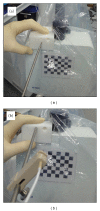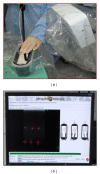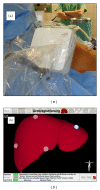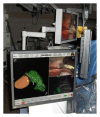Laparoscopic navigated liver resection: technical aspects and clinical practice in benign liver tumors
- PMID: 23133783
- PMCID: PMC3485494
- DOI: 10.1155/2012/265918
Laparoscopic navigated liver resection: technical aspects and clinical practice in benign liver tumors
Abstract
Laparoscopic liver resection has been performed mostly in centers with an extended expertise in both hepatobiliary and laparoscopic surgery and only in highly selected patients. In order to overcome the obstacles of this technique through improved intraoperative visualization we developed a laparoscopic navigation system (LapAssistent) to register pre-operatively reconstructed three-dimensional CT or MRI scans within the intra-operative field. After experimental development of the navigation system, we commenced with the clinical use of navigation-assisted laparoscopic liver surgery in January 2010. In this paper we report the technical aspects of the navigation system and the clinical use in one patient with a large benign adenoma. Preoperative planning data were calculated by Fraunhofer MeVis Bremen, Germany. After calibration of the system including camera, laparoscopic instruments, and the intraoperative ultrasound scanner we registered the surface of the liver. Applying the navigated ultrasound the preoperatively planned resection plane was then overlain with the patient's liver. The laparoscopic navigation system could be used under sterile conditions and it was possible to register and visualize the preoperatively planned resection plane. These first results now have to be validated and certified in a larger patient collective. A nationwide prospective multicenter study (ProNavic I) has been conducted and launched.
Figures








References
-
- Fabiani P, Katkhouda N, Iovine L, Mouiel J. Laparoscopic fenestration of biliary cysts. Surgical Laparoscopy & Endoscopy. 1991;1(3):162–165. - PubMed
-
- Wayand W, Woisetschlager R. Laparoscopic resection of liver metastasis. Chirurg. 1993;64(3):195–197. - PubMed
-
- Azagra JS, Goergen M, Gilbart E, Jacobs D. Laparoscopic anatomical (hepatic) left lateral segmentectomy—technical aspects. Surgical Endoscopy. 1996;10(7):758–761. - PubMed
LinkOut - more resources
Full Text Sources

